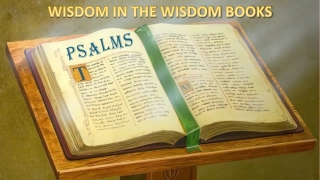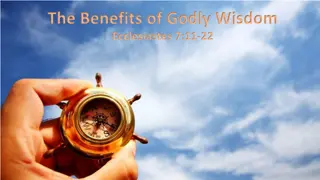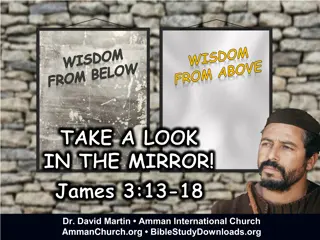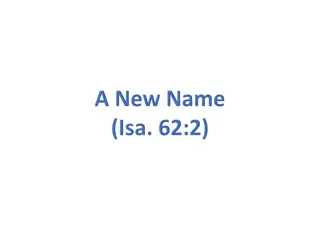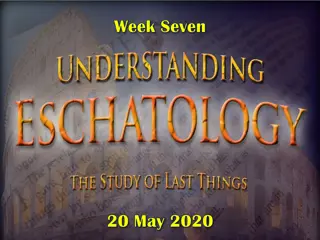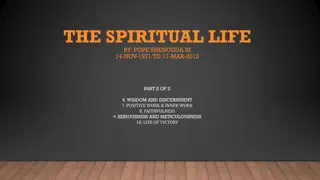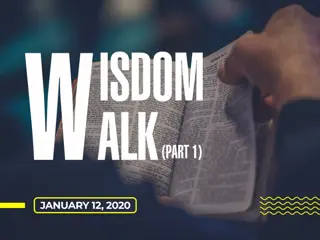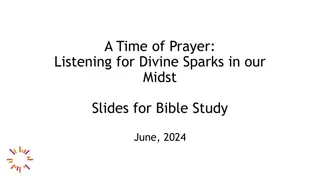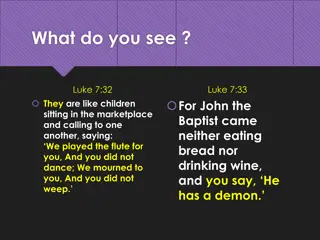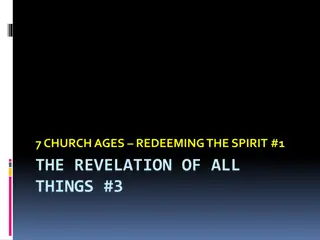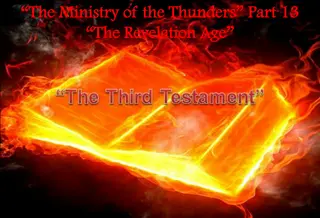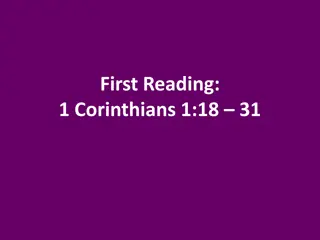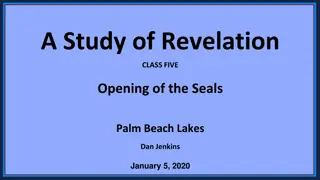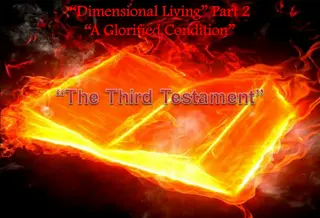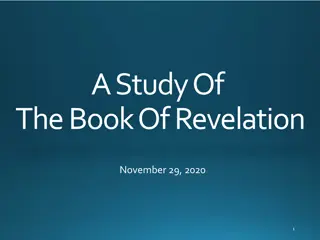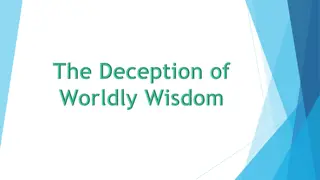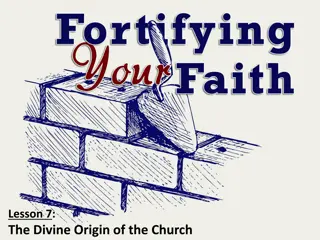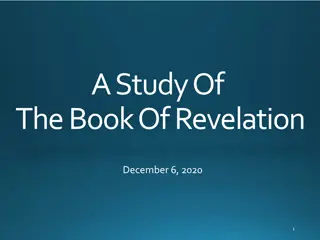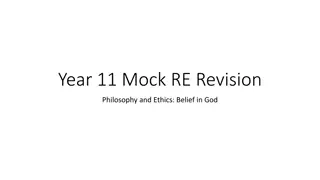Insights on Divine Wisdom: Unveiling the Bahá'í Revelation
Delve into the teachings of the Bahá'í Faith through the concept of exegesis, emphasizing the importance of interpreting sacred texts with understanding rather than personal interpretation. Learn how to immerse yourself in the ocean of divine wisdom to uncover hidden gifts and pearls of knowledge, following the guidance of Bahá'u'lláh and other authoritative figures. Explore the systematic process of exegesis and the significance of studying the Holy Scriptures word by word to attain a deeper understanding of spiritual truths.
Download Presentation

Please find below an Image/Link to download the presentation.
The content on the website is provided AS IS for your information and personal use only. It may not be sold, licensed, or shared on other websites without obtaining consent from the author. Download presentation by click this link. If you encounter any issues during the download, it is possible that the publisher has removed the file from their server.
E N D
Presentation Transcript
Windows on Divine Wisdom: Accessing the Meaning of the Bah Revelation By Dr. Sandra Lynn Hutchison
Immerse yourselves in the ocean of My words, that ye may unravel its secrets, and discover all the pearls of wisdom that lie hid in its depths. (Bah u ll h, Gleanings, 136)
How to immerse yourself in the ocean of His Words: Learning to read well and deeply = learning the strokes
Inspire then my soul, O my God, with Thy wondrous remembrance, that I may glorify Thy name. Number me not with them who read Thy words and fail to find Thy hidden gift which, as decreed by them, is contained therein, and which quickeneth the souls of Thy creatures and the hearts of Thy servants. (Bah u ll h, Prayers and Meditations, 83)
Exegesis: Finding the hidden gift Exegesis, according to its etymology, is the act of reading a text in such a way as to draw the meaning out. Exegesis is the opposite of what has come to be known as eisegesis, which is the act of reading one s own meaning into the text. Exegesis involves a systematic process by which a person forms an understanding of a text and arrives at a reasonable and coherent sense of its meaning.
Exegesis: Investigate and Study Word by Word It is my hope that you may . . . investigate and study the Holy Scriptures word by word so that you may attain knowledge of the mysteries hidden therein. ( Abdu l-Bah , The Promulgation of Universal Peace, 459)
Exegesis: Forming an Understanding versus Authoritative Interpretation of the Texts Individual Bah s are free to employ a whole range of literary and exegetical tools to draw the meaning out of a text and form their own understanding of it exegesis. The understanding an individual Bah forms of a text does not constitute an authoritative interpretation. Readers must look to the commentary of Abdu l- Bah and Shoghi Effendi for authoritative interpretation of the texts.
The Engaged Reader The Enlightened Reader Metaphorical Mindset Knowledge of Literary and Exegetical Tools, such as those used in Windows on Divine Wisdom Lifelong Commitment to Mastering the Art of Reading and Achieving High Literacy Determination Not Only to Read But to Understand Long-Term Plan for the Systematic Study of the Texts Reads with: eagerness and love * spirit of joy and radiance * clean heart and pure mind + * Bah u ll h, The Kit b-i-Aqdas, q68: 125. + Abdu l-Bah , Paris Talks, 16.8: 49.
A Long-term Plan for Systematic Study But this Develop a Five Year Plan for Reading the Writings of Bah u ll h in Chronological Order Allot So Many Months Per Work and So Much Time Per Day to Reading Use Literary and Exegetical Tools, such as Windows on Divine Wisdom Not this
Reading versus Understanding Be not satisfied with words, but seek to understand the spiritual meanings hidden in the heart of the words. It is not the reading of the words that profits you; it is the understanding of their meanings. ( Abdu l-Bah , The Promulgation of Universal Peace, 459)
A Metaphorical Mindset = Avoid literal mindedness in reading scripture. Read with an awareness that the language of scripture is often symbolic. Seek out the inner meaning of the words.
Abdul-Bah Explains the Difference between Literal and Symbolic Meaning: The Holy Books have their special terminologies which must be known and understood. . . . In the scripture we read that Zion is dancing. It is evident that this has other than literal interpretation. The meaning is that the people of Zion shall rejoice. . . . Again in scriptures it is said, The trees of the field shall clap their hands. This is symbolical. ( Abdu l-Bah , The Promulgationof Universal Peace, 246)
Inner (Symbolic) versus Outer (Literal) Meaning The divine Words are not to be taken according to their outer sense. They are symbolical and contain realities of spiritual meaning. For instance, in the book of Solomon s songs you will read about the bride and bridegroom. It is evident that the physical bride and bridegroom are not intended. Obviously, these are symbols conveying a hidden and inner significance. ( Abdu l-Bah , The Promulgation of Universal Peace, 459)
Shoghi Effendi Explains the Difference Between Metaphorical and Literal Wine: The wine mentioned in the Tablets has undoubtedly a spiritual meaning for in the book of Aqdas we are definitely forbidden to take not only wine, but every thing that deranges the mind. In poetry as a whole wine is taken to have a different connotation than the ordinary intoxicating liquid. We see it thus used by the Persian Poets such as Sa d and Umar Khayam and H fiz to mean that element which nears man to his divine beloved, which makes him forget his material self so as better to seek his spiritual desires.It is very necessary to tell the children what this wine means so that they may not confuse it with the ordinary wine. (Shoghi Effendi, 4 November 1926 letter to an individual, in Lights of Divine Guidance, Vol. 2, 9 10)
Abdul-Bah on the Joy of Reading the Holy Scriptures: If a man understands the real meaning of a poet's verses such as those of Shakespeare, he is pleased and rejoiced. How much greater his joy and pleasure when he perceives the reality of the Holy Scriptures and becomes informed of the mysteries of the Kingdom! ( Abdu l-Bah , The Promulgation of Universal Peace, 460)
The Challenge of Reading the Bah Writings High Literacy to the Word of God Low Literacy From Gothic & Graphic Novels ... http://th00.deviantart.net/fs50/PRE/i/2009/291/8/d/Watchmen_Book_Cover_by_Hailfeather_Rules.jpg
The Language of Translation = Early Modern English/ King James English (The Language of Shakespeare) The quality of mercy is not strain'd, Itdroppeth as the gentle rain from heaven Upon the place beneath: it is twice blest; Itblesseth him that gives and him that takes: 'Tis mightiest in the mightiest: it becomes The throned monarch better than his crown; His sceptre shows the force of temporal power, The attribute to awe and majesty, Wherein doth sit the dread and fear of kings; But mercy is above this sceptred sway; It is enthroned in the hearts of kings, It is an attribute to God himself; And earthly power doth then show likest God's When mercy seasons justice . . . (Shakespeare, The Merchant of Venice, Act 4, Scene 1)
O SON OF SPIRIT! The best beloved of all things in My sight is Justice; turn not away therefrom if thoudesirest Me, and neglect it not that I may confide in thee. By its aid thou shalt see with thineown eyes and not through the eyes of others, and shalt know of thine own knowledge and not through the knowledge of thy neighbor. Ponder this in thy heart; how itbehooveth thee to be. Verily justice is My gift to thee and the sign of My loving- kindness. Set it then before thineeyes. (Bah u ll h, The Hidden Words, Arabic No. 2)
Where to begin? Just you and the text a single passage from a tablet, a treatise, a letter, a talk, a book
It is easy to read what others have written about a text, but much harder to acquire the discipline and high literacy to read the text yourself. NO SKIMMING! This takes practice at http://i.imgur.com/ZQLOu.gif reading carefully reading slowly reading with attention * investigate and study . . . word by word ( Abdu l-Bah ,Promulgation, 459)
Windows: From a Microscopic View of the Text to a Telescopic View of the Text Later you may want to take a telescopic view of the text by examining the world into which it was born and in which it lives. Start off by taking a microscopic view of the text, analyzing closely individual passages.
Nine Nine Windows on Divine Wisdom Windows on Divine Wisdom 1. Diction (Word Choice) 1. Diction (Word Choice) 2. Figurative Language 2. Figurative Language 3. Theme 3. Theme 4. Structure 4. Structure 5. The Work 5. The Work 6. Genre 6. Genre 7. Oeuvre 7. Oeuvre 8. Biographical and Historical Context 8. Biographical and Historical Context 9. Literary and Scriptural Traditions 9. Literary and Scriptural Traditions
View the text through the first four View the text through the first four Windows any help from outside sources. any help from outside sources. Windows without without 1. Diction 1. Diction 2. Figurative language 2. Figurative language 3. Theme 3. Theme 4. Structure 4. Structure * *Reading independently will help you develop Reading independently will help you develop high literacy confidence confidence and and capacity capacity to see with your own eyes, not with the eyes of to see with your own eyes, not with the eyes of others. others. (Bah u ll h, (Bah u ll h, The Hidden The Hidden Words, Arabic No. 2) Words, Arabic No. 2) high literacy the the
The First Window: Diction (Word Choice) O YE PEOPLE THAT HAVE MINDS TO KNOW AND EARS TO HEAR! The first call of the Beloved is this: O mystic nightingale! Abide not but in the rose garden of the spirit. O messenger of the Solomon of love! Seek thou no shelter except in the Sheba of the well-beloved, and O immortal phoenix! dwell not save on the mount of faithfulness. Therein is thy habitation, if on the wings of thy soul thou soarest to the realm of the infinite and seekest to attain thy goal. (Bah u ll h, The Hidden Words, Persian No. 1) *Diction (Word Choice) Why abide instead of dwell or nest ? What does dwell mean here? How is it different from abide ? What is a habitation ? How is it different from a home or dwelling place?
The Second Window: Figurative Language Figurative Language language using figures of speech (a way of saying one thing and meaning another) in other words, language that cannot be taken literally (or should not be taken literally). Similes, metaphors etc. Use a dictionary of literary terms, such as Holman and Hunt to learn the names and definitions of a whole range of literary devices. Online sources: http://www.scribd.com/doc/176690651/A-Handbook-to- Literature-4th-Edition-by-C-Hugh-Holman-1985#scribd www.ohio.edu/people/hartleyg/ref../abrams_mh.pdf https://web.cn.edu/kwheeler/lit_terms.html
The Second Window: Figurative Language O YE PEOPLE THAT HAVE MINDS TO KNOW AND EARS TO HEAR! The first call of the Beloved is this: O mystic nightingale! Abide not but in the rose garden of the spirit. O messenger of the Solomon of love! Seek thou no shelter except in the Sheba of the well-beloved, and Oimmortal phoenix! dwell not save on the mount of faithfulness. Therein is thy habitation, if on the wings of thy soul thou soarest to the realm of the infinite and seekest to attain thy goal. (Bah u ll h, The Hidden Words, Persian No. 1) *Some examples of Figurative Language: opening address apostrophe/epithet symbols: mystic nightingale and immortal phoenix metaphors: rose garden of the spirit and mount of faithfulness
The Third Window: Theme O YE PEOPLE THAT HAVE MINDS TO KNOW AND EARS TO HEAR! The first call of the Beloved is this: O mystic nightingale! Abide not but in the rose garden of the spirit. O messenger of the Solomon of love! Seek thou no shelter except in the Sheba of the well-beloved, and O immortal phoenix! dwell not save on the mount of faithfulness. Therein is thy habitation, if on the wings of thy soul thou soarest to the realm of the infinite and seekest to attain thy goal. (Bah u ll h, The Hidden Words, Persian No. 1) *Theme (condensed into one sentence): The Beloved (Bah u ll h) is calling the faithful to dwell in the garden of the spirit that is, in the spiritual world, which is the true habitation or native dwelling place of the soul.
The Fourth Window: Structure O YE PEOPLE THAT HAVE MINDS TO KNOW AND EARS TO HEAR! The first call of the Beloved is this: O mystic nightingale! Abide not but in the rose garden of the spirit. O messenger of the Solomon of love! Seek thou no shelter except in the Sheba of the well-beloved, and O immortal phoenix! dwell not save on the mount of faithfulness. Therein is thy habitation, if on the wings of thy soul thou soarest to the realm of the infinite and seekest to attain thy goal. (Bah u ll h, The Hidden Words, Persian No. 1) *Structure: At the simplest level, the reader can see that this Hidden Word is structured around a series of phrases that begin with O an exclamatory vocative. In the first instance, O is followed by an address (apostrophe) to the readers, who are described in terms of their qualities (epithet). Each of the O phrases builds on the previous one to convey a sense of urgency and escalating emotional intensity. This Hidden Word is the first of 82 others in the Persian section and, thus, sets the tone for what follows.
Viewing the Text through the Last Five Viewing the Text through the Last Five Windows Windows May Require Research May Require Research 5. The Work 5. The Work 6. Genre 6. Genre 7. Oeuvre 7. Oeuvre 8. Biographical and Historical Context 8. Biographical and Historical Context 9. Literary and Scriptural Traditions 9. Literary and Scriptural Traditions
Where to begin your research? https://encrypted-tbn2.gstatic.com/images?q=tbn:ANd9GcRHgL9O1jBrvdtAhlnw0Anpp_EZXUnvN0D8jXgU8iXI27lSIe_T
Useful Resources (Books): Historical Accounts Abdu l-Bah s A Traveler s Narrative and Memorials of the Faithful Shoghi Effendi s God Passes By and Nabil s Narrative Reference Books A Basic Bah Dictionary, ed. Wendi Momen (GR Books, 1989) A Concise Encyclopedia of the Bah Faith, by Peter Smith (One World, 2000) A Basic Bah Chronology, by Glenn Cameron and Wendi Momen (GR Books, 1996) Historical Dictionary of the Bah Faith, 2d ed., by Hugh Adamson (Scarecrow Press, 1998)
Useful Websites http://www.reference.bahai.org/ http: //www.bahai.org/ http://bahai-library.com/ http://www.bahai-encyclopediaproject.org/
And One of Shoghi Effendis Favorite Resources: In his translation work, Shoghi Effendi took great care to find the precise word, often using the third or fourth definition of that word as listed in the dictionary. A careful reader should know at least the first meaning of every single word he/she reads.
One particularly comprehensive source: http:www.bahai.org/ (with access to http: www.reference.bahai.org/) How to Navigate the Site: Authoritative Writings and Guidance Writings and Talks of Abdu l-Bah Sidebar More About the Life and Ministry of Abdu l-Bah What Bah s Believe: Abdu l-Bah , the Perfect Exemplar Exploring this Topic Articles and Resources Other Resources and Materials Commentaries on the Writings of Abdu l-Bah and Other Literature * The Writings of Abdu l-Bah by Amin Banani
The Fifth Window: The Work For commentary by Abdu l-Bah on works by the B b and Bah u ll h, search individual titles in The Works of Abdu l-Bah at reference.bahai.org. For commentary by Shoghi Effendi on works by the Central Figures, search The Works of Shoghi Effendi at reference.bahai.org. Use the title of the work about which you are seeking information to launch your search.
When searching the works of Shoghi Effendi for commentary on other texts, always start with God Passes By In God Passes By, his history of the first 100 years of the Bah Faith, Shoghi Effendi summarizes the themes of the most of the works revealed by Bah u ll h, the B b, and Abdu l-Bah , and evaluates their significance. In many cases, he also offers historical context and biographical information, including when the work was written and where it fits in the context of the oeuvre.
Then go on to other works by Shoghi Effendi Commentary by Shoghi Effendi on The Secret of Divine Civilization can be found in The World Order of Bah u ll h, 37: In The Secret of Divine Civilization ( The Mysterious Forces of Civilization ), Abdu l-Bah s outstanding contribution to the future reorganization of the world, we read the following: True civilization will unfurl its banner in the midmost heart of the world whenever a certain number of its distinguished and high-minded sovereigns the shining exemplars of devotion and determination shall, for the good and happiness of all mankind, arise, with firm resolve and clear vision, to establish the Cause of Universal Peace.
The Fifth Window: The Work The Secret of Divine Civilization holds a pre-eminent position among the literature of modernization in Persia. The Secret of Divine Civilization is important because it presents the earliest and the only coherent scheme for the modernization of Persia. Unlike the reforms suggested in other treatises of the day, Abdu l-Bah s proposals are rooted in divine guidance. *All this information was gleaned from Amin Banani s The Writings of Abdu l-Bah available on www.bahai.org
The Sixth Window: Genre *Knowing the genre (or form) of the work helps us to understand its purpose and intention *The Secret of Divine Civilization is a treatise (Banani) What is a treatise? Treatise: A written work dealing formally and systematically with a subject: his treatise on Scottish political theory (Oxford Dictionaries) Treatise (on something) (formal) a long and serious piece of writing on a particular subject. A Treatise of Human Nature by David Hume. Any of these questions would deserve a lengthy treatise, perhaps even a small book. (Oxford Advanced Learner s Dictionary)
The Seventh Window: Oeuvre Written in 1875,The Secret of Divine Civilization is one of Abdu l- Bah s earliest works. It is one of three books and treatises written by Abdu l-Bah , includingA Traveller s Narrative (1886) and a short volume entitled A Treatise on Politics (1893). A Treatise on Politics, which has not yet been translated into English, can be viewed as a sequel to The Secret of Divine Civilization. The Secret of Divine Civilization is addressed to the Persian nation; A Treatise on Politics is addressed to the Bah community of Iran. *All of this information was gleaned from Amin Banani s article The Writings of Abdul-Bah available on www.bahai.org.
The Eighth Window: Biography and History Questions to Ask: What was the condition of the Bah community at the time the work was revealed? What significant events took place in the lives of Bah u ll h and Abdu l-Bah ? What relevant events took place in the country of Palestine and, more broadly, in the region of the Middle East and in the world?
The Eighth Window: Biographical Context DO ANY OF THESE BIOGRAPHICAL FACTS SHED LIGHT ON THE WORK? Abdu'l-Bah wrote and published The Secret of Divine Civilization anonymously. (evident from reading the text itself) Bah u ll h had recently finished writing His various tablets to the rulers. (see God Passes By) Abdu'l-Bah wrote The Secret of Divine Civilization at the request of Bah 'u'll h, seventeen years before His ascension. (see Nader Saeidi s Introduction to Abdu'l-Bah 's The Secret of Divine Civilization, available on www.bahai.org) Bah u ll h and His family had moved from the prison and were living in the House of Abb d. (see A Basic Bah Dictionary) Abdul-Bah had recently married Mun rih Kh num. (seeA Basic Bah Chronology)
The Eighth Window: Historical Context During the nineteenth century, Iranians became aware that Western countries were rapidly surpassing Iran and the Islamic world, both economically and culturally. Iranian intellectuals became preoccupied with questions of reform and modernization. Reforms were opposed by the clergy and impossible to achieve due to the corruption of officialdom at all levels of Iranian society. *All this information was gleaned from Nader Saeidi s Introduction to Abdu l-Bah s The Secret of Divine Civilization, available on www.bahai.org.
The Ninth Window: Literary and Scriptural Traditions Intertextuality: Investigating the relationship between The Secret of Divine Civilization and another work of resembling it may reveal similarities in genre, style, structure, or purpose. Or an allusion in The Secret of Divine Civilization may suggest turning to the work that is the source of that allusion. For example, in The Secret of Divine Civilization there are a number of allusions to Rumi, one of the Persian mystical poets. Reading the allusions in their original context will enrich the understanding of the passages in which they appear in The Secret of Divine Civilization.
The Ninth Window: Literary Tradition Where does this work fit in the genre of the treatise as it was practiced in both Western and in Eastern traditions? A simple google search of the phrase well-known political treatises brings up Machiavelli s The Prince and John Locke s Two Treatises of Government, among others. Any of these treatises can be read alongside The Secret of Divine Civilization. Saeidi sarticle offers an extensive discussion of Abdu l-Bah s view of the state relative to those advanced by various political theorists of the Enlightenment. A subsequent investigation might be undertaken in order to to place The Secret of Divine Civilization in the context of political treatises written in Iran in the nineteenth century and earlier.
The Ninth Window: Scriptural Tradition There are three allusions to the Qur n and one to a Holy Tradition on the first two pages of The Secret of Divine Civilization. Abdul-Bah is speaking to a Muslim audience. creation and first in rank, taking precedence over all created things. Witness to it is the Holy Tradition, Before all else, God created the mind. From the dawn of creation, it was made to be revealed in the temple of man. Sanctified is the Lord, Who with the dazzling rays of this strange, heavenly power has made our world of darkness the envy of the worlds of light: And the earth shall shine with the light of her Lord. 1Holy and exalted is He, Who has caused the nature of man to be the dayspring of this boundless grace: The God of mercy hath taught the Qur n, hath created man, hath taught him articulate speech. 2 This supreme emblem of God [intellect] stands first in the order of
Remember the Nine Windows on Divine Wisdom and Use Them! 1. Diction 1. Diction 2. Figurative Language 2. Figurative Language 3. Theme 3. Theme 4. Structure 4. Structure 5. The Work 5. The Work 6. Genre 6. Genre 7. Oeuvre 7. Oeuvre 8. Biographical and Historical Context 8. Biographical and Historical Context 9. Literary and Scriptural Traditions 9. Literary and Scriptural Traditions
Resolutions for the Aspiring Enlightened Reader 1. While participating in Ruhi Study Circles and enjoying the close reading and fellowship that takes place in that context, I will develop a plan for the systematic study of the Bah writings so that I read beyond the excerpts contained in the Ruhi books, which constitute only a fraction of the revealed Word of God. 2. I will familiarize myself with and learn to use various literary and exegetical tools, such as those introduced in Windows on Divine Wisdom. 3. I will maintain a metaphorical mindset and make a commitment to read the entire body of Bah scripture, perusing each text word by word that is, slowly, carefully, and with attention and investigating each text with the goal of understanding its inner meaning.
The Reader Who Engages with the Texts and Keeps these Resolutions is An Enlightened Reader Who Has Found the Hidden Gift







